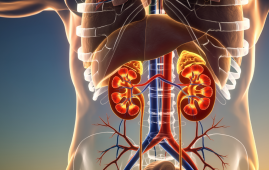

Researchers assessed the effects of antidepressant usage, postmenopausal mortality, and epigenetic age acceleration (EAA) in a new study that was published in Aging.
Context
The most common mental illness among older people, depression adds to the worldwide burden of disease. Chronic illnesses like diabetes, metabolic syndrome, and cardiovascular disease are at risk due to it.
Among older adults, antidepressants are often recommended medications. There is little data regarding the long-term effects of antidepressant treatment, however, about 25% of people who are prescribed antidepressants continue to take them for more than ten years.
Antidepressants are linked to several negative side effects, despite their possible health advantages. People who have gone through menopause are at a higher risk of developing depression and using antidepressants. Antidepressant use or depression symptoms may make them more susceptible to age-related illnesses.
Concerning the study
Researchers looked at the connection between postmenopausal individuals’ higher depression symptoms (EDSs), antidepressant use, and EAA, or all-cause mortality.
They made use of information from the Women’s Health Initiative (WHI), a lengthy research conducted in the US from 1993 to 1998 that drew a multiethnic population.
Participants filled out a questionnaire and had a clinical checkup when they were enrolled. Only individuals possessing DNA methylation data for calculating epigenetic age were included in the current investigation. An algorithm was created to measure depressive symptoms; a score of more than 0.06 indicated a serious case of depression.
To look at temporal changes, EDSs were assessed again at enrollment and again during a three-year follow-up. The use of antidepressants was also looked at for temporal alterations. Four epigenetic clocks—Hannum, PhenoAge, GrimAge, and Horvath—were used to characterize EAA.
Every six months or a year, the cause of death was determined by checking in with family, friends, and caregivers. The study participants were monitored through December 31, 2021.
Health, lifestyle, and sociodemographic variables were among the covariates. For survival probabilities against baseline EDSs, antidepressant use, and combined exposure (EDSs plus antidepressant use), the team produced Kaplan-Meier estimates.
The odds and hazard ratios were calculated using logistic or Cox proportional hazard regression models. Bivariate relationships between EAA, EDS/antidepressant use, and the risk of all-cause mortality and baseline health, lifestyle, and socioeconomic factors.
In addition, the association between antidepressant use, EDS, and EAA was assessed. The moderating or mediating effects of EAA on the relationship between EDSs/antidepressants and mortality risk were investigated by causal mediation studies.
Model 2 was somewhat modified (only socioeconomic factors were taken into account), model 3 included further adjustments for lifestyle and health-related factors, and model 1 was left uncorrected.
Results
The analysis comprised 1,900 postmenopausal individuals in all. At baseline, the average age was 64.6, with 32% of Black people and approximately 66% of White people.
Of them, 7% had used antidepressants at baseline and 11% had EDSs. A mean of 20.4 years of follow-up resulted in 1,161 documented deaths. The combined exposure and baseline antidepressant use were strongly linked to an increased risk of all-cause mortality.
Age, increasing physical activity, education, and wealth all decreased the likelihood of EDSs or combined exposure, whereas body mass index and current smokers raised the odds. Age-related increases in the risks of all causes of death were observed, with Black and Hispanic participants showing lower risks than While and non-Hispanic subjects, respectively.
Only GrimAge acceleration was linked to combined exposure in the crude and partially adjusted models of logistic regression to antidepressant use.
Furthermore, a higher mortality risk was linked to an increase in antidepressant use between baseline and the three-year follow-up. During this period, changes in EDS status did not affect death.
Causal mediation analysis revealed that, in the partially adjusted model only, GrimAge acceleration partially mediated the effects of baseline antidepressant usage and the combined exposure on the probability of all-cause mortality.
In conclusion
Overall, the study assessed the effect of EAA, depressive symptoms, and antidepressant usage on postmenopausal individuals’ all-cause mortality. All-cause mortality risks were predicted by baseline antidepressant usage, longitudinal increases in antidepressant use, and accelerated epigenetic aging.
Before controlling for health and lifestyle characteristics, GrimAge acceleration partially mediated the effects of baseline antidepressant usage and combination EDS/antidepressant use on mortality risk. Additional research with a variety of populations is needed.
For more information: Relationships of depression and antidepressant use with epigenetic age acceleration and all-cause mortality among postmenopausal women, Aging, https://doi.org/10.18632/aging.205868
more recommended stories
 Phage Therapy Study Reveals RNA-Based Infection Control
Phage Therapy Study Reveals RNA-Based Infection ControlKey Takeaways (Quick Summary) Researchers uncovered.
 Pelvic Floor Disorders: Treatable Yet Often Ignored
Pelvic Floor Disorders: Treatable Yet Often IgnoredKey Takeaways (Quick Summary) Pelvic floor.
 Urine-Based microRNA Aging Clock Predicts Biological Age
Urine-Based microRNA Aging Clock Predicts Biological AgeKey Takeaways (Quick Summary) Researchers developed.
 Circadian Control of Neutrophils in Myocardial Infarction
Circadian Control of Neutrophils in Myocardial InfarctionKey Takeaways for HCPs Neutrophil activity.
 E-Cigarette Use and Heart Attack Risk in Former Smokers
E-Cigarette Use and Heart Attack Risk in Former SmokersKey Takeaways for Clinicians and Nurses.
 36-Week Pre-eclampsia Screening May Reduce Term Risk
36-Week Pre-eclampsia Screening May Reduce Term RiskA New Preventive Strategy for Term.
 Cardiovascular Risk and Sudden Cardiac Death in Diabetes
Cardiovascular Risk and Sudden Cardiac Death in DiabetesRising Sudden Cardiac Death (SCD) Risk.
 Poor Kidney Function and Alzheimer’s Biomarkers Explained
Poor Kidney Function and Alzheimer’s Biomarkers ExplainedPoor kidney function may influence levels.
 Walking Speed Before Hip Replacement Predicts Recovery
Walking Speed Before Hip Replacement Predicts RecoveryNew Evidence Points to a Simple,.
 Neuroblastoma Drug Combo Extends Survival in Models
Neuroblastoma Drug Combo Extends Survival in ModelsA Promising Shift in High-Risk Neuroblastoma.

Leave a Comment